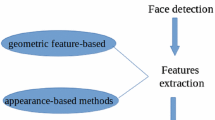Abstract
To overcome the disadvantage of classical recognition model that cannot perform well enough when there are some noises or lost frames in expression image sequences, a novel model called fuzzy buried Markov model (FBMM) is presented in this paper. FBMM relaxes conditional independence assumptions for classical hidden Markov model (HMM) by adding the specific cross-observation dependencies between observation elements. Compared with buried Markov model (BMM), FBMM utilizes cloud distribution to replace probability distribution to describe state transition and observation symbol generation and adopts maximum mutual information (MMI) method to replace maximum likelihood (ML) method to estimate parameters. Theoretical justifications and experimental results verify higher recognition rate and stronger robustness of facial expression recognition for image sequences based on FBMM than those of HMM and BMM.
Similar content being viewed by others
References
Sun W, Ruan Q Q. Two-dimension PCA for facial expression recognition. In Proc. IEEE International Conference on Signal Processing (ICSP 2000), Guilin, China, Nov. 11–14, 2006, Vol.3.
Tsai D M, Lai S C. Defect detection in periodically patterned surfaces using independent component analysis. Pattern Recognition, 2008, 41(9): 2812–2832.
Sang N, Wu J W, Yu K. Local Gabor fisher classifier for face recognition. In Proc. the 4th International Conference on Image and Graphics, Chengdu, China, Aug. 22–24, 2007, pp.620–626.
Pardµas M, Bonafonte A. Facial animation parameters extraction and expression detection using Hidden Markov Models. Signal Process: Image Commun., 2002, 17(9): 675–688.
Aleksic P S, Katsaggelos A K. Automatic facial expression recognition using facial animation parameters and multistream HMMs. IEEE Transactions on Information Forensics and Security, 2006, 1(1): 3–11.
Zhou X X, Huang X S, Xu B, Wang Y S. Real-time facial expression recognition based on boosted embedded hidden Markov model. In Proc. International Conference on Image and Graphics, Hong Kong, China, Dec. 18–20, 2004, pp.290–293.
Ma L, Chelberg D, Celenk M. Spatio-temporal modeling of facial expressions using Gabor wavelets and hierarchical Hidden Markov Models. In Proc. IEEE International Conference on Image Processing (ICIP 2005), Genoa, Italy, Sept. 11–14, 2005, Vol. 2, pp.57–60.
Bilmes J A. Buried Markov models: A graphical-modeling approach to automatic speech recognition. Computer Speech and Language, 2003, 17(2/3): 213–231.
Tarihi M R, Teheri A, Bababeyk H. A new method for fuzzy hidden Markov models in speech recognition. In Proc. IEEE International Conference on Emerging Technologies (ICET 2005), Islamabad, Pakistan, Sept. 17–18, 2005, pp.36–40.
Zhu Y F, Dai C H, Chen W R, Lin J H. Adaptive probabilities of crossover and mutation in genetic algorithms based on cloud model. Journal of Computational Information Systems, 2005, 1(4): 671–678.
Lima C S, Cardoso M J. Cardiac Arrhythmia detection by parameters sharing and MMIE training of Hidden Markov Models. In Proc. 29th Annual International Conference of the IEEE Engineering in Medicine and Biology Society (EMBS2007), Lyon, France, Aug. 23–26, 2007, pp.3836–3839.
Normandin Y, Cardin R, Mori R D. High-performance connected digit recognition using maximum mutual information estimation. IEEE Transactions on Speech and Audio Processing, 1994, 2(2): 299–311.
Kim D, Yook D. Linear spectral transformation for robust speech recognition using maximum mutual information. Signal Processing Letters, 2007, 14(7): 496–499.
Shiratori N, Okude N. Bayesian networks layer model to represent anesthetic practice. In Proc. IEEE International Conference on Systems, Man and Cybernetics, Montreal, Canada, Oct. 7–10, 2007, pp.674–679.
Chen B, Liao Q, Tang Z H. A clustering based Bayesian network classifier. In Proc. Fourth International Conference on Fuzzy Systems and Knowledge Discovery (FSKD2007), Haikou, China, Aug. 24–27, 2007, pp.444–448.
Zhan Y Z, Ye J F, Niu D J et al. Facial expression recognition based on Gabor wavelet transformation and elastic templates matching. International Journal of Image and Graphics, 2006, 6(1): 125–138.
Deng W H, Hu J N, Guo J, Zhang HG. Robust discriminant analysis of Gabor feature for face recognition. In Proc. Fourth International Conference on Fuzzy Systems and Knowledge Discovery (FSKD 2007), Haikou, China, Aug. 24–27, 2007, pp.248–252.
Bilmes J A. Buried Markov models for speech recognition. In Proc. IEEE International Conference on Acoustics, Speech, and Signal Processing (ICASSP 1999), Vol.2, Phoenix, Arizona, Mar. 15–19, 1999, pp.713–716.
Author information
Authors and Affiliations
Corresponding author
Additional information
This work is supported by the National Natural Science Foundation of China under Grant No. 60673190.
Rights and permissions
About this article
Cite this article
Zhan, YZ., Cheng, KY., Chen, YB. et al. A New Classifier for Facial Expression Recognition: Fuzzy Buried Markov Model. J. Comput. Sci. Technol. 25, 641–650 (2010). https://doi.org/10.1007/s11390-010-9353-x
Received:
Revised:
Published:
Issue Date:
DOI: https://doi.org/10.1007/s11390-010-9353-x




